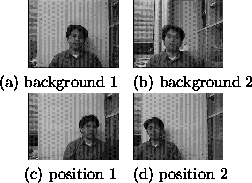 |
As shown in the section 2.2, PARCOR coefficients for
stationary regions such as background become 0. This means that HLAC
features extracted from PARCOR images do not affected by changes of
background. To confirm this property of the proposed features, the
recognition rates were estimated with different backgrounds
(Fig.4 (a) and (b)). In this experiment, 360 samples
from two backgrounds (20 samples ![]() 9 categories
9 categories ![]() 2 backgrounds) was used. The recognition rate estimated by leave one
out method was 97.5%.
2 backgrounds) was used. The recognition rate estimated by leave one
out method was 97.5%.
Next, to confirm the generalization ability to changes of background, discriminant mapping was constructed by using samples with one background and then the recognition rate of samples with the other background was evaluated. The recognition rate of 100% was achieved when gestures with background 1 (Fig.4 (a)) was tested using discriminant space learned for the background 2 (Fig.4 (b)). The recognition rate of inverse direction was 99.4%. This shows that the proposed features are robust to changes of background.
Since the HLAC features are invariant to the shift in the image, the
recognition system using the proposed features also becomes robust to
changes of the position of the person who is doing a gesture. To
confirm this property of the proposed features, we have performed
experiments to estimate the recognition rates with different positions
of the person (Fig.4 (c) and (d)). In this experiment, 120
samples from two positions (30 samples ![]() 2 categories (yes
and no)
2 categories (yes
and no) ![]() 2 positions) was used. The recognition rate
estimated by leave one out method was 95%.
2 positions) was used. The recognition rate
estimated by leave one out method was 95%.
Similar to the previous experiment, to confirm the generalization ability to changes of person's position, discriminant mapping was constructed by using samples with one position and then the recognition rate of samples with the other position was evaluated. The recognition rates were 98.3% and 96.7%. These results shows that the proposed features are robust to changes of person's positions.